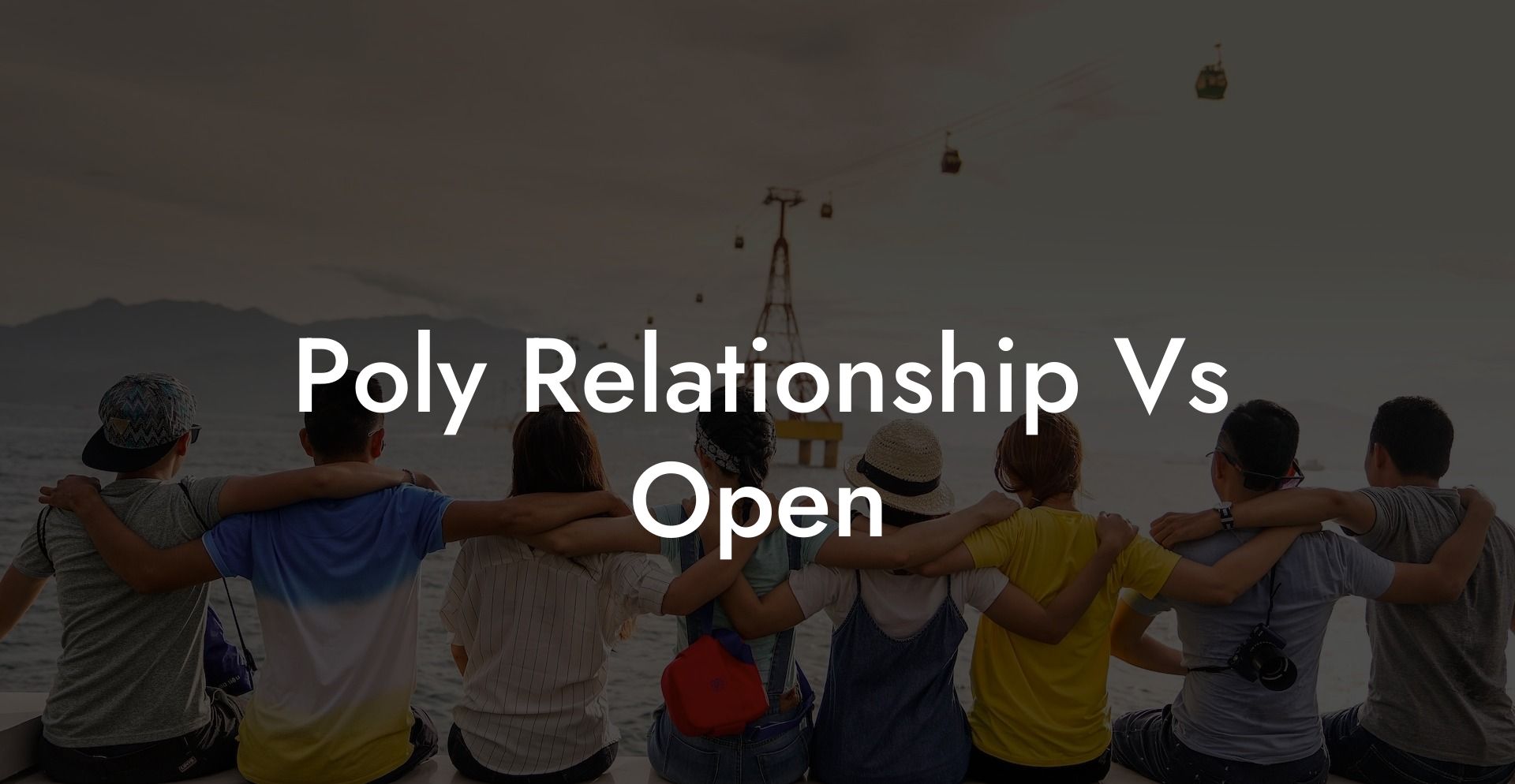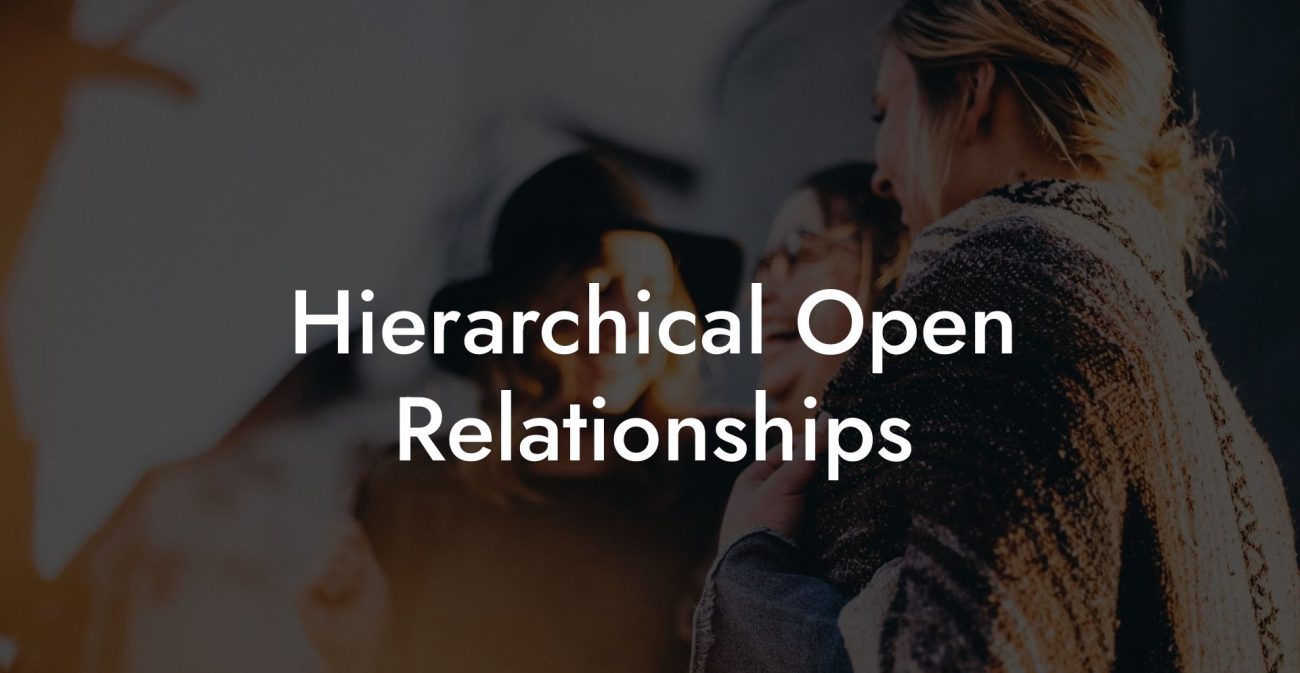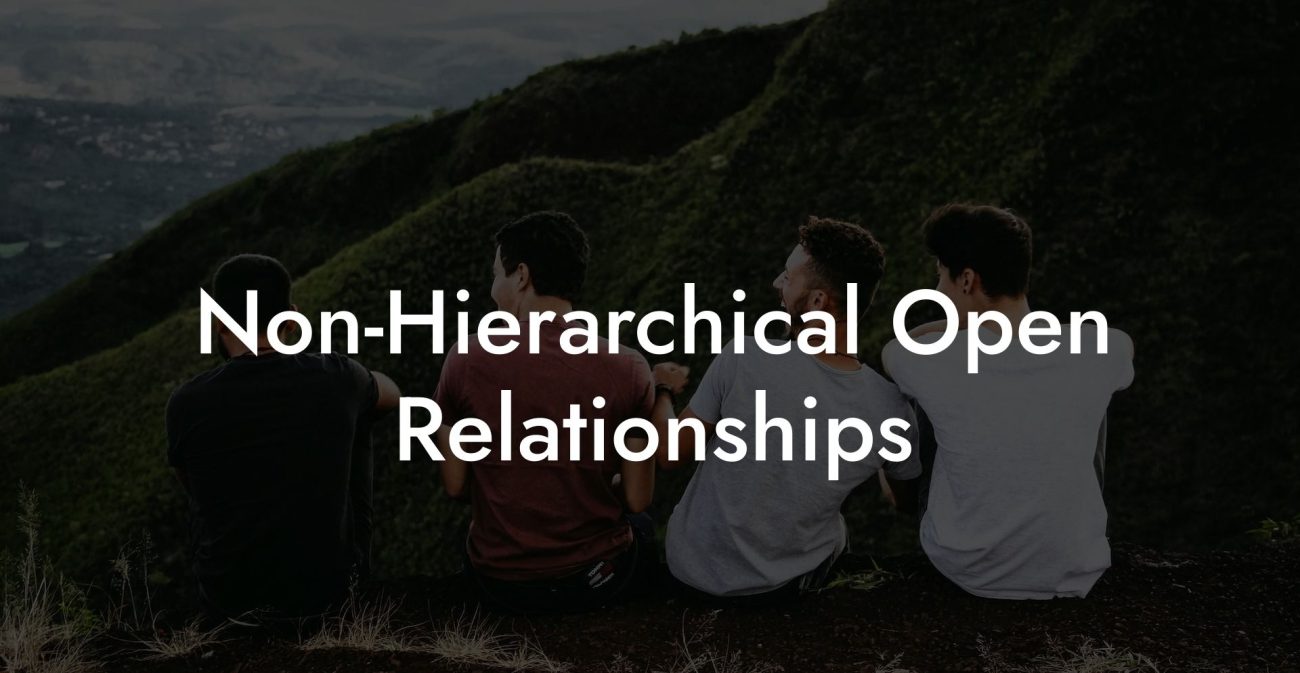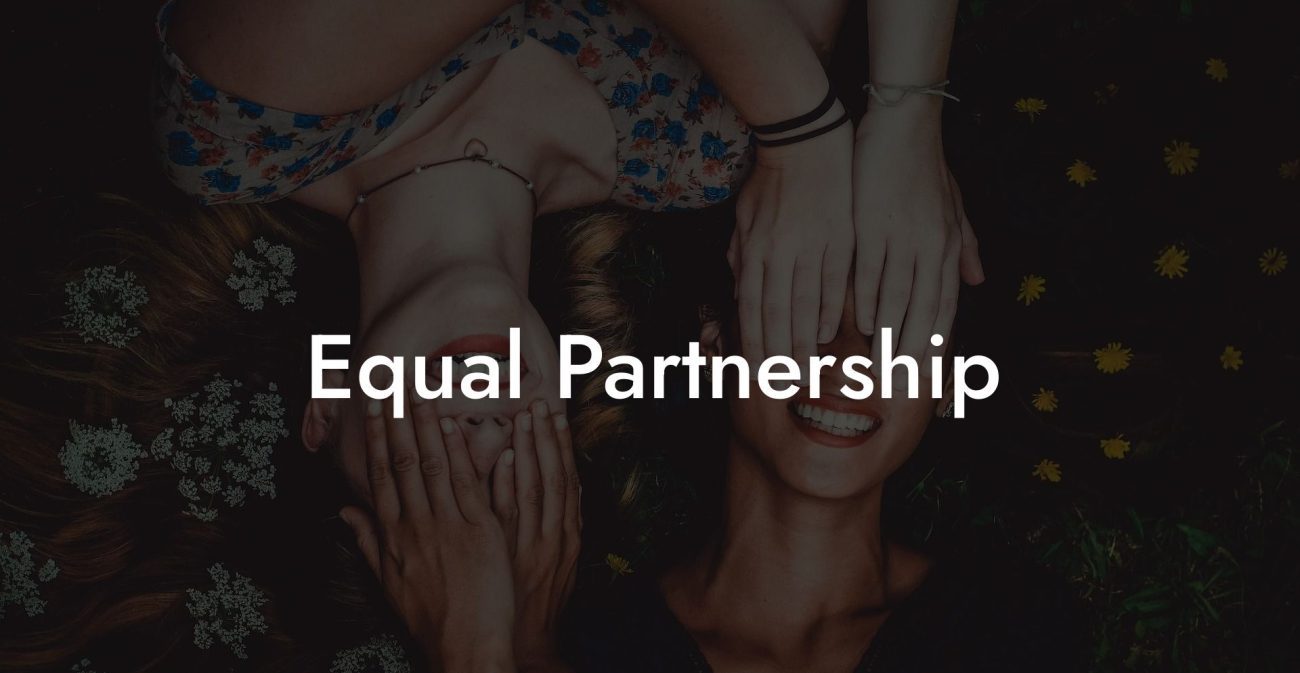Poly Relationship vs Open: Key Differences

In today’s dynamic world of relationships, many individuals are exploring diverse ways to connect with others beyond traditional monogamy. Two popular models that often spark confusion are poly relationships and open relationships. Although both are forms of consensual non-monogamy, they differ significantly in structure, commitment, communication, and emotional dynamics. This guide delves deep into the definitions, historical backgrounds, ethical considerations, legal perspectives, and psychological impacts of each model. Whether you are considering an alternative lifestyle or simply curious about how these relationship structures work, this resource will provide you with clear insights and practical strategies to help you navigate your options.
Quick Links to Useful Sections
- Defining Poly Relationships
- What Are Poly Relationships?
- Common Variations Within Poly Relationships
- Defining Open Relationships
- What Is an Open Relationship?
- Common Variations Within Open Relationships
- Historical and Cultural Perspectives
- Evolution of Relationship Models
- Societal Acceptance and Legal Frameworks
- Core Principles and Values
- Communication and Consent
- Emotional Intelligence and Self-Awareness
- Flexibility and Adaptability
- Key Differences Between Poly Relationships and Open Relationships
- Structure and Commitment
- Emotional and Psychological Dynamics
- Communication and Negotiation
- Legal and Social Recognition
- Flexibility and Personal Autonomy
- Benefits and Challenges
- Benefits of Poly Relationships
- Benefits of Open Relationships
- Challenges in Poly Relationships
- Challenges in Open Relationships
- Practical Strategies for Success
- For Poly Relationships
- For Open Relationships
- FAQ: Your Poly Relationship vs Open Questions Answered
Defining Poly Relationships
What Are Poly Relationships?
Poly relationships, often referred to as polyamorous relationships, involve forming and maintaining multiple romantic or sexual connections simultaneously with the full knowledge and consent of everyone involved. In a poly relationship, each connection can have its own unique level of commitment and intensity. Some poly relationships are structured hierarchically, with one relationship designated as primary and others as secondary, while others are non-hierarchical, where all relationships are considered equally important.
Key characteristics of poly relationships include:
- Consensual Non-Monogamy: Every partner is aware of and agrees to the multiple relationships.
- Varied Levels of Commitment: Relationships can range from casual encounters to deep, long-term commitments.
- Emphasis on Emotional Connection: Many individuals in poly relationships value the diversity of emotional support and intimacy they receive from multiple partners.
- Flexibility: The structure of poly relationships is often fluid, allowing for ongoing renegotiation of boundaries and commitments as personal needs change.
Common Variations Within Poly Relationships
Poly relationships come in various forms, including:
- Hierarchical Polyamory: One relationship is considered primary, while other relationships are viewed as secondary.
- Non-Hierarchical Polyamory: All relationships are regarded equally, without a set ranking or hierarchy.
- Solo Polyamory: Individuals maintain multiple relationships while prioritizing personal autonomy, often without designating any single relationship as primary.
- Relationship Anarchy: A model that rejects traditional labels and hierarchies, allowing relationships to develop organically based on mutual interests and consent.
Defining Open Relationships
What Is an Open Relationship?
An open relationship is a consensual arrangement in which a couple agrees that one or both partners may pursue sexual and/or romantic interactions outside of their primary bond. Unlike poly relationships, which often focus on cultivating multiple deep, emotionally meaningful connections, open relationships typically emphasize maintaining a central, primary partnership while allowing for occasional external encounters.
The core elements of open relationships include:
- Mutual Consent: Every partner is fully informed and agrees to the arrangement.
- Negotiated boundaries: Clear guidelines are set regarding what types of interactions are acceptable.
- Transparency: Ongoing communication ensures that all parties remain comfortable and informed about changes in the arrangement.
- Flexibility: The structure is adaptable, allowing the relationship to evolve as individual needs and desires change.
Common Variations Within Open Relationships
Open relationships can vary in their level of involvement:
- Sex-Only Open Relationships: Partners allow external sexual encounters while keeping emotional relationships exclusive.
- Emotional and Sexual Open Relationships: Both romantic and sexual relationships outside the primary bond are permitted.
- Occasional Open Arrangements: Some couples agree on limited external engagements while prioritizing their primary relationship most of the time.
Historical and Cultural Perspectives
Evolution of Relationship Models
Both poly relationships and open relationships are part of a broader historical continuum of non-monogamous practices. Throughout history, various cultures have embraced forms of consensual non-monogamy, ranging from communal living arrangements and plural marriages to more fluid forms of love. With the advent of modern communication and increased social awareness, individuals today are challenging traditional monogamous norms and seeking relationship models that better align with their personal values.
Cultural shifts have paved the way for more diverse expressions of love and intimacy. While open relationships often emerged as a way for couples to explore sexual variety without dissolving their primary bond, poly relationships have grown from a desire to create multiple deep emotional connections simultaneously.
Societal Acceptance and Legal Frameworks
Monogamy remains the legally recognized and socially dominant model in many parts of the world, which means that both poly relationships and open relationships often lack formal legal recognition. However, social acceptance of consensual non-monogamy is growing, especially in progressive communities. Understanding these cultural and legal contexts is essential when exploring either relationship model.
Core Principles and Values
Communication and Consent
Whether you are in a poly relationship or an open relationship, robust communication is vital. Transparent, ongoing dialogue ensures that all partners understand each other’s needs, set clear boundaries, and navigate changes as they occur. In both models, consent is continuous and must be revisited regularly to maintain trust and mutual respect.
Emotional Intelligence and Self-Awareness
Managing multiple relationships or balancing external connections requires a high degree of emotional intelligence. Self-awareness helps you understand your own feelings and manage potential challenges such as jealousy or insecurity. By cultivating these skills, you can create healthier and more resilient relationships.
Flexibility and Adaptability
Both relationship models require the ability to adapt. Open relationships offer flexibility in exploring external connections without fundamentally altering the primary bond, while poly relationships often involve dynamic adjustments as multiple emotional needs evolve over time.
Key Differences Between Poly Relationships and Open Relationships
Structure and Commitment
Poly Relationships: Emphasize forming multiple, simultaneous relationships that are often deep, long-term, and emotionally significant. The structure can be hierarchical, with primary and secondary partners, or non-hierarchical, where all relationships are seen as equally important. Commitment in poly relationships tends to be multifaceted, with each connection having its own unique role and significance.
Open Relationships: Typically involve a primary couple that allows for additional romantic or sexual interactions on a more casual or occasional basis. The primary bond is central, and external relationships are often viewed as supplementary rather than integral to one’s emotional life.
Emotional and Psychological Dynamics
Poly Relationships: Offer a diverse range of emotional support from multiple partners. This can lead to enriched experiences of intimacy and personal growth. However, managing multiple deep connections requires advanced communication and emotional regulation skills.
Open Relationships: Focus on maintaining a strong, exclusive emotional bond within the primary couple while exploring additional connections primarily for sexual or casual romantic fulfillment. This model may involve less emotional complexity regarding external relationships but still requires effective management of feelings such as jealousy.
Communication and Negotiation
Poly Relationships: Demand ongoing, multi-directional communication among all partners. Negotiating boundaries and expectations across several relationships can be complex and requires transparency and a high level of trust.
Open Relationships: Involve a focused dialogue between the primary partners to set rules and boundaries regarding external interactions. Communication is centered on preserving the primary relationship while allowing for some level of external exploration.
Legal and Social Recognition
Poly Relationships: Often exist outside of traditional legal frameworks and do not have the same legal recognition as monogamous marriages. This can present challenges regarding rights and benefits, but many polyamorous communities work to create alternative support systems.
Open Relationships: Similarly lack formal legal recognition, as they are generally not structured as legal marriages. However, they are often more socially accepted than polyamorous arrangements due to the prevailing norm of a primary couple.
Flexibility and Personal Autonomy
Poly Relationships: Provide significant flexibility by allowing individuals to form multiple, meaningful connections simultaneously. This approach can empower personal growth and diversify the sources of emotional and social support.
Open Relationships: Offer freedom to explore additional sexual or romantic experiences while maintaining a core, exclusive bond. This balance allows for personal autonomy without the full commitment required in poly relationships.
Benefits and Challenges
Benefits of Poly Relationships
- Diverse Emotional Support: Multiple relationships provide various forms of intimacy and care.
- Opportunities for Personal Growth: Managing multiple connections can foster self-awareness, resilience, and improved communication skills.
- Flexibility in Love: Poly relationships allow for a broad exploration of what love means to you, without the limitations of a two-person model.
Benefits of Open Relationships
- Focused Core Bond: The primary relationship remains the central commitment, providing stability and security.
- Sexual and Emotional Exploration: Allows for additional experiences and growth outside the core relationship, without diluting the primary bond.
- Simplicity in Management: Since the focus is mainly on the primary couple, the communication and logistical challenges are often less complex than in full poly relationships.
Challenges in Poly Relationships
- Emotional Complexity: Balancing multiple deep relationships requires advanced communication and emotional management skills.
- Time and Resource Allocation: Coordinating the needs and schedules of multiple partners can be demanding.
- Jealousy and Insecurity: The presence of several intimate connections may lead to feelings of jealousy, which must be managed through continuous dialogue and self-awareness.
Challenges in Open Relationships
- Boundary Negotiation: Defining what constitutes acceptable external interactions requires clear, ongoing negotiation.
- Maintaining the Primary Bond: It can be challenging to ensure that external relationships do not interfere with the emotional and physical intimacy of the core partnership.
- Social Stigma: Despite growing acceptance, open relationships may still face criticism or misunderstanding from those who favor traditional monogamous models.
Practical Strategies for Success
For Poly Relationships
- Regular Communication: Hold group and one-on-one check-ins with all partners to discuss boundaries, feelings, and expectations.
- Establish Clear Agreements: Create written or digital agreements outlining roles, responsibilities, and guidelines for interaction.
- Invest in Emotional Intelligence: Practice mindfulness, seek therapy if needed, and work on self-awareness to manage complex emotions.
- Use Digital Tools: Leverage shared calendars and communication apps to coordinate time and keep everyone informed.
For Open Relationships
- Focus on the Primary Bond: Prioritize your core relationship while setting clear rules for external interactions.
- Schedule Regular Check-Ins: Have regular, dedicated conversations with your partner about how external relationships are affecting your primary bond.
- Negotiate Boundaries: Clearly define what is acceptable regarding external sexual or romantic interactions and revisit these boundaries as needed.
- Maintain Self-Care: Ensure that you dedicate time to personal well-being through hobbies, exercise, and relaxation techniques.
FAQ: Your Poly Relationship vs Open Questions Answered
1. What is a poly relationship?
A poly relationship is a form of consensual non-monogamy where individuals maintain multiple, simultaneous romantic or sexual relationships, often with deep emotional connections and varying levels of commitment.
2. What is an open relationship?
An open relationship is a consensual arrangement where a couple maintains a primary bond while allowing one or both partners to engage in additional romantic or sexual interactions outside of that bond.
3. How do the commitment levels differ between poly relationships and open relationships?
Poly relationships often involve multiple, deeply committed relationships that may be hierarchical or non-hierarchical, whereas open relationships focus on preserving a primary, exclusive partnership while exploring additional connections on a more flexible or casual basis.
4. What are the key communication differences?
Poly relationships require multi-directional communication among several partners, whereas open relationships primarily involve communication between the primary couple about external interactions.
5. How do legal and social recognitions differ?
Both models generally lack formal legal recognition, but monogamy tends to have stronger social and legal support. Open relationships, as part of a primary couple, are often more socially accepted than poly relationships, which involve multiple concurrent bonds.
6. What challenges are common in poly relationships?
Common challenges include managing complex emotional dynamics, balancing time and resources among multiple partners, and handling feelings of jealousy or insecurity.
7. What challenges do open relationships face?
Open relationships may face challenges in maintaining the primary bond while negotiating external interactions, as well as potential social stigma from those who favor traditional monogamous models.
8. Where can I find more resources on these topics?
Additional resources include books such as "The Ethical Slut" by Dossie Easton & Janet Hardy and "More Than Two" by Franklin Veaux & Eve Rickert, podcasts like "Multiamory" and "Polyamory Weekly," and online communities such as r/polyamory.
Resources and Community Support: Your Next Steps
- "The Ethical Slut" by Dossie Easton & Janet Hardy – A seminal work exploring ethical non-monogamy and alternative relationship models.
- "More Than Two" by Franklin Veaux & Eve Rickert – A guide offering practical advice on managing relationship dynamics in both poly and open relationship contexts.
- Podcasts: Listen to "Multiamory" and "Polyamory Weekly" for engaging discussions and personal stories about different relationship models.
- Online Communities: Join forums such as r/polyamory to exchange ideas, experiences, and support.
- Workshops and Webinars: Attend events focused on relationship psychology and ethical non-monogamy to expand your knowledge and network with like-minded individuals.
By exploring these resources and applying the strategies outlined in this guide, you can develop a clear and informed understanding of the key differences between open relationships and monogamy. Embrace continuous learning, open communication, and self-reflection as you navigate the diverse landscape of intimacy and commitment.
Lost & confused by all of the terms, types and seemingly made up 3 letter acronyms?? We've got you. Check out our Ethnical Non-Monogamy Dictionary >>
Useful Interruption: Not sure which relationship vibe fits you best? Take our Relationship Test, it’ll give you the real insight into your natural relationship style. Then, dive into our binge-worthy guides (from the tried-and-true to the “wait, that’s a thing?”) and find the perfect relationship type for your life:
- Monogamy
- Open Relationships
- Ethical Non-Monogamy
- Solo Polyamory
- Non-Hierarchical Polyamory
- Hierarchical Polyamory
- Relationship Anarchy
- Swinging
Now back to the main article but yeah take the test...












